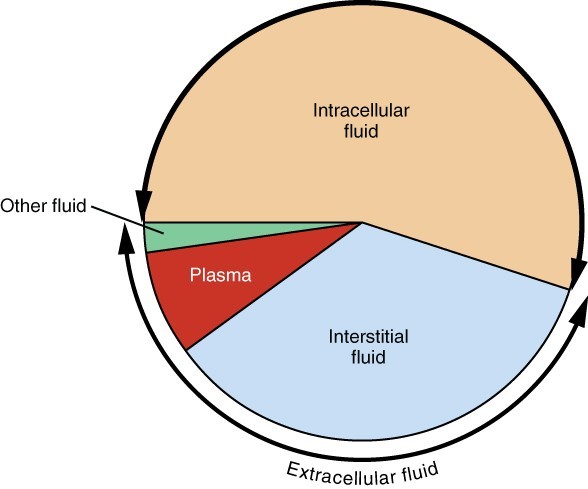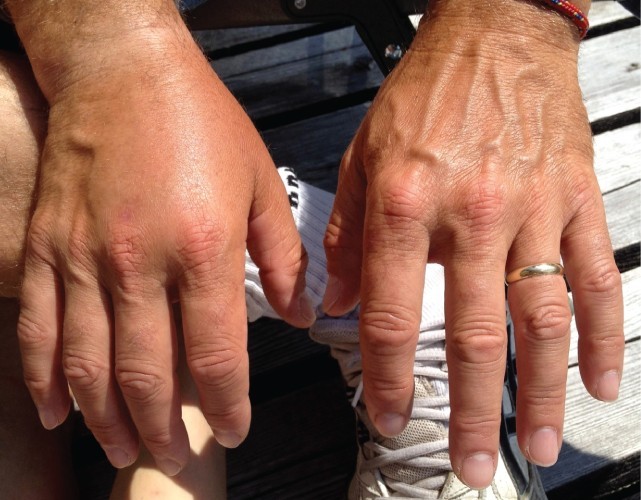Does ECF have more fluid compared to ICF? Understanding the distribution of fluids in the body is crucial for maintaining overall health. At COMPARE.EDU.VN, we provide comprehensive comparisons to help you understand complex biological processes, ensuring you have the knowledge to make informed decisions.
1. Introduction to Body Fluids and Compartments
The human body is composed of approximately 50-75% water, depending on age, sex, and body composition. This water is distributed among various fluid compartments, each with distinct characteristics and functions. These compartments are primarily the intracellular fluid (ICF) and the extracellular fluid (ECF). Understanding the composition and distribution of these fluids is essential for comprehending physiological processes and maintaining homeostasis.
1.1. Importance of Water in the Body
Water serves as a universal solvent, facilitating numerous biochemical reactions necessary for life. It plays a vital role in:
- Nutrient Transport: Carrying nutrients to cells.
- Waste Removal: Eliminating metabolic waste products.
- Temperature Regulation: Maintaining a stable body temperature.
- Cellular Function: Ensuring proper cell volume and structure.
1.2. Overview of Fluid Compartments
Body fluids are compartmentalized into two main categories:
- Intracellular Fluid (ICF): Fluid inside the cells.
- Extracellular Fluid (ECF): Fluid outside the cells.
The ECF is further divided into:
- Interstitial Fluid (IF): Fluid surrounding the cells, not within blood vessels.
- Plasma: Fluid component of blood.
2. Intracellular Fluid (ICF) in Detail
The intracellular fluid (ICF) is the fluid located within the cells. It is the largest fluid compartment in the body, comprising about 60% of the total body water.
2.1. Volume and Distribution of ICF
- Volume: Approximately 25 liters in an average adult male.
- Distribution: Contained within the cell membranes of all cells in the body.
2.2. Composition of ICF
The ICF has a unique composition that differs significantly from the ECF. Key components include:
- High Concentrations: Potassium (K+), Phosphate (HPO4^2-), Magnesium (Mg2+), and Proteins.
- Low Concentrations: Sodium (Na+), Chloride (Cl-), and Bicarbonate (HCO3-).
2.3. Functions of ICF
The ICF is crucial for various cellular functions, including:
- Maintaining Cell Shape: Providing structural support.
- Facilitating Metabolic Processes: Acting as a medium for biochemical reactions.
- Transporting Substances: Moving nutrients and waste within the cell.
3. Extracellular Fluid (ECF) in Detail
The extracellular fluid (ECF) is the fluid located outside the cells. It makes up about one-third of the total body water and is essential for transporting substances between cells and maintaining a stable environment for cellular function.
3.1. Volume and Distribution of ECF
- Volume: Approximately 15 liters in an average adult male.
- Distribution: Divided into plasma (about 3 liters) and interstitial fluid (about 12 liters). Other minor components include transcellular fluids like cerebrospinal fluid, synovial fluid, and aqueous humor.
3.2. Composition of ECF
The ECF has a composition distinct from the ICF, characterized by:
- High Concentrations: Sodium (Na+), Chloride (Cl-), and Bicarbonate (HCO3-).
- Low Concentrations: Potassium (K+), Phosphate (HPO4^2-), Magnesium (Mg2+), and Proteins (lower in IF than in plasma).
3.3. Functions of ECF
The ECF serves several critical functions:
- Transport: Delivering nutrients and removing waste products from cells.
- Communication: Facilitating cell-to-cell communication.
- Regulation: Maintaining fluid and electrolyte balance.
4. Does ECF Have More Fluid Compared To ICF? A Direct Comparison
To answer the question, “Does ECF have more fluid compared to ICF?”, let’s directly compare the volumes of the two compartments.
4.1. Volume Comparison
- ICF Volume: Approximately 25 liters (60% of total body water).
- ECF Volume: Approximately 15 liters (40% of total body water).
Based on these figures, the ICF contains significantly more fluid than the ECF.
4.2. Reasons for the Difference
The larger volume of ICF is due to:
- Cellular Mass: The total volume occupied by all the cells in the body is substantial.
- Metabolic Needs: Cells require a significant amount of water to carry out metabolic processes.
4.3. Visual Representation
5. Key Differences Between ICF and ECF
To further clarify the distinction between ICF and ECF, let’s examine their key differences in terms of composition, function, and regulation.
5.1. Compositional Differences
| Component | Intracellular Fluid (ICF) | Extracellular Fluid (ECF) |
|---|---|---|
| Sodium (Na+) | Low | High |
| Potassium (K+) | High | Low |
| Chloride (Cl-) | Low | High |
| Bicarbonate (HCO3-) | Low | High |
| Proteins | High | Low (lower in IF) |
| Phosphate (HPO4^2-) | High | Low |
| Magnesium (Mg2+) | High | Low |



5.2. Functional Differences
| Function | Intracellular Fluid (ICF) | Extracellular Fluid (ECF) |
|---|---|---|
| Primary Role | Supporting cellular metabolism | Transporting nutrients and waste |
| Nutrient Supply | Receives nutrients from ECF | Delivers nutrients to cells |
| Waste Removal | Transfers waste to ECF | Removes waste from cells |
| Volume Regulation | Regulated by intracellular processes | Regulated by hormones and kidney function |
| Ion Composition | High K+, Mg2+, HPO4^2-; Low Na+, Cl- | High Na+, Cl-, HCO3-; Low K+, Mg2+, HPO4^2- |
5.3. Regulatory Mechanisms
| Regulation | Intracellular Fluid (ICF) | Extracellular Fluid (ECF) |
|---|---|---|
| Primary Regulators | Cellular processes | Hormones and Kidneys |
| Hormonal Control | Limited direct control | Aldosterone, ADH, ANP |
| Kidney Involvement | Indirect | Direct |
| Osmotic Balance | Maintained by cell | Maintained systemically |
6. Fluid Movement Between Compartments
The movement of fluids between the ICF and ECF is governed by several factors, including osmotic pressure, hydrostatic pressure, and membrane permeability.
6.1. Osmotic Pressure
Osmotic pressure is the pressure exerted by solutes in a solution that pulls water across a semi-permeable membrane from an area of lower solute concentration to an area of higher solute concentration. This process is critical for maintaining fluid balance between the ICF and ECF.
6.2. Hydrostatic Pressure
Hydrostatic pressure is the pressure exerted by a fluid against a wall. In the context of fluid movement, hydrostatic pressure in capillaries forces fluid out into the interstitial space.
6.3. Membrane Permeability
The cell membrane is selectively permeable, allowing some substances to pass through while restricting others. Water moves freely through aquaporins, while the movement of ions and larger molecules is regulated by specific transport proteins.
7. Role of Electrolytes in Fluid Balance
Electrolytes play a crucial role in maintaining fluid balance and regulating various physiological processes.
7.1. Major Electrolytes and Their Functions
- Sodium (Na+): Primarily found in the ECF, regulates fluid volume and nerve function.
- Potassium (K+): Primarily found in the ICF, essential for nerve and muscle function.
- Chloride (Cl-): Major anion in the ECF, helps maintain fluid balance and acid-base balance.
- Bicarbonate (HCO3-): Buffers blood pH and helps transport carbon dioxide.
- Calcium (Ca2+): Important for muscle contraction, nerve function, and blood clotting.
- Magnesium (Mg2+): Involved in enzyme reactions, muscle and nerve function.
- Phosphate (HPO4^2-): Important for bone formation and energy metabolism.
7.2. Electrolyte Balance and Homeostasis
Maintaining electrolyte balance is essential for proper cellular function. Imbalances can lead to various health problems, including:
- Hyponatremia: Low sodium levels.
- Hypernatremia: High sodium levels.
- Hypokalemia: Low potassium levels.
- Hyperkalemia: High potassium levels.
8. Clinical Significance of Fluid Compartments
Understanding the fluid compartments and their regulation is crucial in clinical medicine for diagnosing and treating various conditions.
8.1. Dehydration
Dehydration occurs when the body loses more fluid than it takes in, leading to a decrease in both ICF and ECF volume. Symptoms include thirst, dizziness, and decreased urine output.
8.2. Edema
Edema is the accumulation of excess fluid in the interstitial space, leading to swelling. It can be caused by various factors, including heart failure, kidney disease, and inflammation.
8.3. Fluid Overload
Fluid overload occurs when there is an excess of fluid in the body, leading to increased ECF and potentially ICF volume. It can be caused by kidney failure, heart failure, or excessive intravenous fluid administration.
9. Maintaining Fluid Balance
Maintaining fluid balance is essential for overall health and involves a complex interplay of hormones, kidneys, and other regulatory mechanisms.
9.1. Hormonal Regulation
- Antidiuretic Hormone (ADH): Released by the pituitary gland, promotes water reabsorption in the kidneys.
- Aldosterone: Released by the adrenal glands, promotes sodium reabsorption in the kidneys, leading to increased water retention.
- Atrial Natriuretic Peptide (ANP): Released by the heart, promotes sodium and water excretion in the kidneys.
9.2. Kidney Function
The kidneys play a crucial role in regulating fluid balance by:
- Filtering Blood: Removing waste products and excess fluid.
- Reabsorbing Water and Electrolytes: Returning essential substances to the bloodstream.
- Excreting Urine: Eliminating excess fluid and waste.
9.3. Lifestyle Factors
- Adequate Hydration: Drinking enough water each day.
- Balanced Diet: Consuming a diet rich in electrolytes and nutrients.
- Limiting Sodium Intake: Reducing sodium consumption to prevent fluid retention.
10. Advanced Concepts in Fluid Dynamics
For a more in-depth understanding, let’s explore some advanced concepts related to fluid dynamics in the body.
10.1. Starling Forces
Starling forces describe the balance between hydrostatic and osmotic pressures that regulate fluid movement across capillary membranes. These forces include:
- Capillary Hydrostatic Pressure (CHP): Pressure of blood against the capillary walls, pushing fluid out.
- Interstitial Fluid Hydrostatic Pressure (IFHP): Pressure of fluid in the interstitial space, pushing fluid in.
- Blood Colloid Osmotic Pressure (BCOP): Osmotic pressure due to proteins in the blood, pulling fluid in.
- Interstitial Fluid Colloid Osmotic Pressure (IFCOP): Osmotic pressure due to proteins in the interstitial space, pulling fluid out.
The net filtration pressure (NFP) is calculated as:
NFP = (CHP + IFCOP) - (IFHP + BCOP)10.2. Donnan Effect
The Donnan effect refers to the unequal distribution of ions across a semi-permeable membrane due to the presence of non-diffusible charged molecules, such as proteins. This effect influences the distribution of electrolytes between the ICF and ECF.
10.3. Gibbs-Donnan Equilibrium
Gibbs-Donnan equilibrium describes the equilibrium state achieved when the electrochemical potential of diffusible ions is equal on both sides of a membrane, taking into account the Donnan effect.
11. Practical Tips for Maintaining Healthy Fluid Levels
Here are some practical tips to help maintain healthy fluid levels:
- Drink Plenty of Water: Aim for at least 8 glasses of water per day.
- Eat Hydrating Foods: Include fruits and vegetables with high water content, such as watermelon, cucumber, and spinach.
- Monitor Electrolyte Intake: Consume a balanced diet with adequate electrolytes.
- Avoid Excessive Sodium: Limit processed foods and salty snacks.
- Stay Active: Regular exercise promotes healthy circulation and fluid balance.
- Listen to Your Body: Pay attention to thirst and other signs of dehydration.
12. Conclusion: Understanding Fluid Compartments
In conclusion, while both intracellular fluid (ICF) and extracellular fluid (ECF) are vital for life, the ICF contains more fluid compared to ECF. Understanding the composition, function, and regulation of these fluid compartments is essential for maintaining overall health.
By comprehending these concepts, you can make informed decisions about your health and lifestyle. For more detailed comparisons and comprehensive information, visit COMPARE.EDU.VN.
13. Call to Action
Are you finding it difficult to compare the different aspects of health and wellness? At COMPARE.EDU.VN, we offer detailed and objective comparisons to help you make informed decisions. Whether you’re comparing health products, understanding medical conditions, or exploring lifestyle choices, we’ve got you covered.
Visit COMPARE.EDU.VN today to explore our comprehensive comparisons and make the best choices for your health. Our team of experts provides accurate and up-to-date information, so you can be confident in your decisions.
For any inquiries, please contact us at:
- Address: 333 Comparison Plaza, Choice City, CA 90210, United States
- WhatsApp: +1 (626) 555-9090
- Website: COMPARE.EDU.VN
14. Frequently Asked Questions (FAQ)
Q1: What is the main difference between ICF and ECF?
The main difference lies in their location and composition. ICF is the fluid inside cells, high in potassium and proteins, while ECF is the fluid outside cells, high in sodium and chloride.
Q2: Why is it important to maintain fluid balance?
Fluid balance is crucial for maintaining cell function, nutrient transport, waste removal, and overall homeostasis.
Q3: How do hormones regulate fluid balance?
Hormones like ADH, aldosterone, and ANP regulate fluid balance by influencing water and sodium reabsorption in the kidneys.
Q4: What are the symptoms of dehydration?
Symptoms of dehydration include thirst, dizziness, decreased urine output, and dry mouth.
Q5: What causes edema?
Edema can be caused by heart failure, kidney disease, inflammation, and other conditions that disrupt fluid balance.
Q6: How can I maintain healthy fluid levels?
Drink plenty of water, eat hydrating foods, maintain a balanced diet, and limit sodium intake.
Q7: What role do electrolytes play in fluid balance?
Electrolytes help regulate fluid distribution, nerve function, and muscle contraction.
Q8: What are Starling forces?
Starling forces describe the balance between hydrostatic and osmotic pressures that regulate fluid movement across capillary membranes.
Q9: What is the Donnan effect?
The Donnan effect refers to the unequal distribution of ions across a semi-permeable membrane due to the presence of non-diffusible charged molecules.
Q10: Where can I find more information about fluid compartments and health?
Visit compare.edu.vn for detailed comparisons and comprehensive information on health and wellness topics.
This comprehensive article aims to provide a thorough understanding of fluid compartments, addressing the question, “Does ECF have more fluid compared to ICF?” while offering practical tips and actionable information for maintaining healthy fluid levels.
